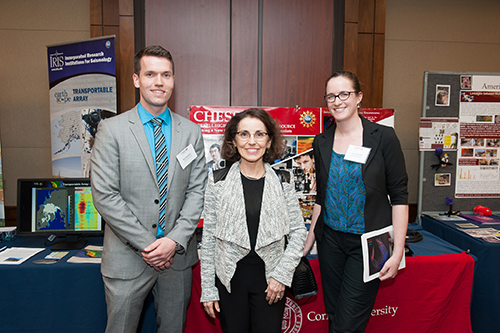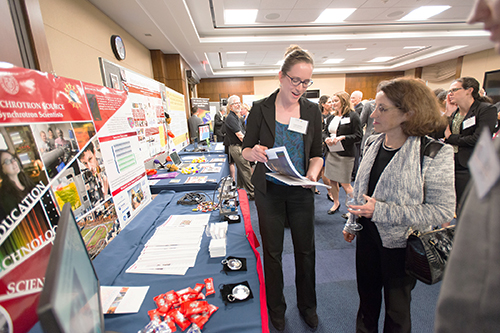X-RAY RUNS: Apply for Beamtime
2017 Nov 1 - Dec 21
2018 Feb 7 - Apr 3
2018 Proposal/BTR deadline: 12/1/17
2018 Apr 11 - Jun 4
2018 Proposal/BTR deadline: 2/1/18
On April 26, CHESS members Joel Brock, Ernie Fontes, Louisa Smieska, and Mark Obstalecki attended the 2016 CNSF (Coalition for National Science Funding) Exhibition in Washington D.C. The theme for the event was "Investments in STEM Research and Education: Fueling American Innovation." The CHESS booth focused on Training a New Generation of Synchrotron Scientists, with Louisa and Mark proving the investment in education at CHESS is unparalleled.

CHESS Postdoctoral Researcher Louisa Smieska, right, and CHESS PhD candidate Mark Obstalecki, left, stand with NSF Director France Córdova in front of the CHESS booth at the CNSF exhibition in Washington D.C.
Louisa shared her experience at CHESS by showcasing examples of her work on x-ray fluorescence mapping with the CHESS Maia detector. A colorful map showing how different elements are distributed throughout a dried shrimp was shared with the permission of Dr. Patrick Parsons’ group from the New York State Department of Health. The map and discussion of the tiny crustacean captured the attention of attendees, especially those nibbling on shrimp cocktail. Others were captivated by the way elemental maps were used by Dr. Jennifer Mass and Alyssa Hull of the Winterthur Museum and University of Delaware to create a digital reconstruction of a School of Rembrandt still life painting from the collection of the Herbert F. Johnson Museum of Art at Cornell.
"I really enjoy sharing this work because the elemental maps are so immediately understandable as images, even if you're not an x-ray specialist. It's so much fun to see someone whose initial attitude is 'I'm not good at science' get excited about the research we're doing at CHESS. I felt like everyone I spoke with could find a point of connection with at least one of the projects Mark and I were presenting," says Louisa.
Mark displayed the load frame he created for InSitµ, discussing the critical nature of the high energy x-rays produced at CHESS which enable engineers to study structural materials in novel ways. He also talked about his interaction with industrial collaborators such as Caterpillar, emphasizing the fact that CHESS provides cutting edge experimental capabilities for engineers along with a knowledgeable staff to educate new users. The environment created at CHESS enables both students and outside users such as Caterpillar to learn about the x-ray diffraction methodology and how to apply the technique to solve their specific engineering problem.
The day included visits from Congressional staffers and National Science Foundation personnel, including NSF Director France Córdova. It was an honor to have Ms. Córdova engage with Mark and Louisa about their compelling scientific research at CHESS. Ms. Córdova’s office oversees all Foundation activities from the development of policy priorities to the establishment of administrative and management guidelines, including long-range planning for the National Science Foundation.

CHESS Postdoctoral Researcher Louisa Smieska, left, shares her examples of x-ray fluorescence mapping with National Science Foundation Director France Córdova at the CNSF exhibition in Washington D.C.
CNSF is an alliance of over 140 professional organizations, universities and businesses united by a concern for the future vitality of the national science, mathematics, and engineering enterprise. CNSF supports the goal of increasing the national investment in the National Science Foundation's research and education programs. These programs increase and develop the knowledge base needed for pushing the frontiers of science, mathematics and engineering disciplines, contribute to the development of the future science and technology workforce, underpin new fields of inquiry, and promote interdisciplinary research and education, all of which facilitate technological innovation.
Submitted by: Rick Ryan, CHESS, Cornell University
05/11/2016
